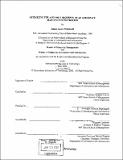| dc.contributor.advisor | Stephen Graves and Deborah Nightingale. | en_US |
| dc.contributor.author | Wolters, James Aaron, 1966- | en_US |
| dc.contributor.other | Leaders for Manufacturing Program. | en_US |
| dc.date.accessioned | 2006-11-08T16:22:46Z | |
| dc.date.available | 2006-11-08T16:22:46Z | |
| dc.date.copyright | 2000 | en_US |
| dc.date.issued | 2000 | en_US |
| dc.identifier.uri | http://theses.mit.edu/Dienst/UI/2.0/Describe/0018.mit.theses%2f2000-123 | en_US |
| dc.identifier.uri | http://hdl.handle.net/1721.1/34707 | |
| dc.description | Thesis (S.M.)--Massachusetts Institute of Technology, Sloan School of Management; and, (S.M.)--Massachusetts Institute of Technology, Dept. of Aeronautics and Astronautics; in conjunction with the Leaders for Manufacturing Program, Massachusetts Institute of Technology, 2000. | en_US |
| dc.description | Also available online at the MIT Theses Online homepage <http://thesis.mit.edu>. | en_US |
| dc.description | Includes bibliographical references (p. 65-66). | en_US |
| dc.description.abstract | The 1990's were a time of downsizing and consolidation for much of the defense aerospace industry. Many defense contractors sought to integrate lean manufacturing principles and techniques into their business, as a means of becoming more cost-competitive in bidding for a shrinking defense budget, and to enable moves into commercial product lines. UTC-Sikorsky Aircraft Company began a series of restructuring and re-engineering initiatives in the late 1990's aimed at addressing these issues. This internship focused on cost reduction in Sikorsky's main product line - the UH-60 Blackhawk helicopter. The final assembly line for the UH-60 was subject to cost and schedule overruns, along with high inventory levels. The assembly line was also characterized by a high degree of variability, and a major source of variability was believed to be the lack of a defined and repeatable sequence for the installations that comprise final ass~mbly. The introduction of an optimized assembly sequence, and subsequent adoption for daily use by shop floor personnel, was expected to reduce variability and improve performance. The use of a sequence itself was expected to produce the following benefits: 1. Provide a significant improvement in the use of visual tools for line management. 2. Help capture valuable information about installations from workers, and then transfer this knowledge to management, planners, and new workers as personnel are rotated through the factory. 3. Enable significant inventory reduction through introduction of a just-in-time (JIT) material delivery methodology, by linking material delivery to the order in which it is consumed. Implementation was expected to aid in identifying the shortcomings and limitations of the systems that have prevented the use of a sequencing methodology in the past. More importantly, it would elevate the importance of addressing and solving these issues as a means to achieve company-wide goals for cost and inventory reduction. Through implementation of this sequence, key issues were identified: -- JIT inventory levels are difficult to achieve in a large, complex aerospace assembly process, -- The manufacturing system, along with systems and processes which support it, must be capable of supporting JIT prior to implementation (and may need to be redesigned to do so), and -- Process re-engineering to support JIT is best accomplished through a combination of top-down and bottom-up change processes. | en_US |
| dc.description.statementofresponsibility | by James Aaron Wolters, II. | en_US |
| dc.format.extent | 89 p. | en_US |
| dc.format.extent | 11426881 bytes | |
| dc.format.extent | 11426638 bytes | |
| dc.format.mimetype | application/pdf | |
| dc.format.mimetype | application/pdf | |
| dc.language.iso | eng | en_US |
| dc.publisher | Massachusetts Institute of Technology | en_US |
| dc.rights | M.I.T. theses are protected by copyright. They may be viewed from this source for any purpose, but reproduction or distribution in any format is prohibited without written permission. See provided URL for inquiries about permission. | en_US |
| dc.rights.uri | http://theses.mit.edu/Dienst/UI/2.0/Describe/0018.mit.theses%2f2000-123 | en_US |
| dc.rights.uri | http://dspace.mit.edu/handle/1721.1/7582 | |
| dc.subject | Sloan School of Management. | en_US |
| dc.subject | Aeronautics and Astronautics. | en_US |
| dc.subject | Leaders for Manufacturing Program. | en_US |
| dc.title | Optimizing the assembly sequence of an aerospace manufacturing process | en_US |
| dc.type | Thesis | en_US |
| dc.description.degree | S.M. | en_US |
| dc.contributor.department | Leaders for Manufacturing Program at MIT | en_US |
| dc.contributor.department | Massachusetts Institute of Technology. Department of Aeronautics and Astronautics | |
| dc.contributor.department | Sloan School of Management | |
| dc.identifier.oclc | 45502935 | en_US |
